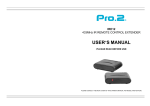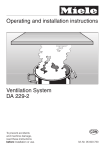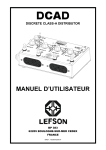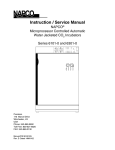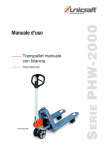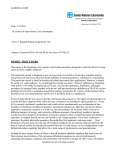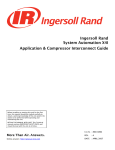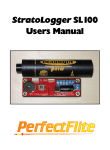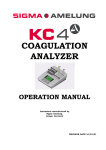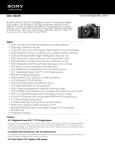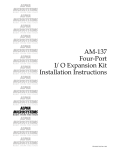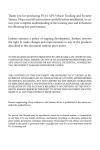Download Instruction / Service Manual
Transcript
Instruction / Service Manual
NAPCO®
Automatic CO2 Incubators
Series 5400
115V Models
Thermo Electron Corporation
170 Marcel Drive
Winchester, VA
USA
Phone: 540-869-9892
Toll Free: 800-621-8820
FAX: 540-869-0130
Manual P/N 36100104(34000120)
Rev. E Dated 12 December, 2004
THIS SYMBOL MARKS CHAPTERS AND SECTIONS OF THIS INSTRUCTION
MANUAL WHICH ARE PARTICULARLY RELEVANT TO SAFETY.
WHEN ATTACHED TO THE UNIT, THIS SYMBOL DRAWS ATTENTION
TO THE RELEVANT SECTION OF THE INSTRUCTION MANUAL.
THIS SYMBOL INDICATES HAZARDOUS VOLTAGES MAY BE PRESENT.
NOTICE
THE MATERIAL IN THIS MANUAL IS FOR INFORMATION
PURPOSES ONLY. THE CONTENTS AND THE PRODUCT IT
DESCRIBES ARE SUBJECT TO CHANGE WITHHOUT NOTICE.
NAPCO MAKES NO REPRESENTATIONS OR WARRANTIES WITH
RESPECT TO THIS MANUAL. IN NO EVENT SHALL NAPCO BE
LIABLE FOR ANY DAMAGES, DIRECT OR INCIDENTAL, ARISING
OUT OF OR RELATED TO THE USE OF THIS MANUAL.
For repair information or replacement parts assistance from the manufacturer,
call Customer Service using our toll free telephone number.
800-621-8820
540-869-9892
(FAX) 540-869-0130
REVISION STATUS
INDEX
DATE
A
6/99
Initial release
B
C
D
11/99
E
AMENDED PAGES
NOTES
5/02
29-31
8/04
30
Update parts list for new kit no's.
Update for coved corners
Update parts list
5, 37
Add stacking instructions
12/04
Contents
1.0 Introduction................................................................................................................... 1
2.0 Unpacking and Damage ............................................................................................... 1
3.0 General and Maintenance Information ....................................................................... 2
4.0 Environmental Conditions and Specifications .......................................................... 3
5.0 Installation .................................................................................................................... 4
6.0 Explanation of Controls ............................................................................................... 5
7.0 Cleaning and Decontamination ................................................................................... 8
8.0 Set-up ............................................................................................................................ 9
9.0 Connecting External Supplies .................................................................................. 11
10.0 Initial Operation & Calibration ................................................................................. 12
11.0 Operation .................................................................................................................. 14
12.0 Care and Cleaning of Stainless Steel ..................................................................... 18
13.0 Troubleshooting Procedures .................................................................................. 21
14.0 Part Replacement Procedures ................................................................................ 26
Replacement Parts List .................................................................................................... 29
Drawings ........................................................................................................................... 31
Warranty ............................................................................................................................ 38
1. 0 Introduction
2.0 Unpacking and Damage
2.01 This product was carefully packed and
thoroughly inspected before leaving our
factory. Save all packing material if apparatus
is received damaged.
1.01 Your satisfaction and safety are important to
NAPCO and a complete understanding of
this unit is necessary to attain these
objectives.
2.02 Responsibility for safe delivery was assumed
by the carrier upon acceptance of the
shipment; therefore, claims for loss or
damage sustained in transit must be made
upon the carrier by the recipient as follows:
1.02 As the ultimate user of this apparatus, you
have the responsibility to understand its proper
function and operational characteristics. This
instruction manual should be thoroughly read
and all operators given adequate training
before attempting to place this unit in service.
Awareness of the stated cautions and
warnings,
and
compliance
with
recommended operating parameters —
together with maintenance requirements —
are important for safe and satisfactory
operation. The unit should be used for its
intended application; alterations or
modifications will void the warranty.
Visible Loss or Damage: Note any external
evidence of loss or damage on the freight bill
or express receipt, and have it signed by the
carrier's agent. Failure to adequately describe
such external evidence of loss or damage
may result in the carrier's refusing to honor
your claim. The form required to file such
claim will be supplied by the carrier.
Concealed Loss or Damage: Concealed
loss or damage is any loss or damage which
does not become apparent until the
merchandise has been unpacked and
inspected. Should either occur, make a
written request for inspection by carrier's
agent within 15 days of the delivery date; then
file a claim with the carrier.
WARNING
AS A ROUTINE LABORATORY PRECAUTION,
ALWAYS WEAR SAFETY GLASSES WHEN
WORKING WITH THIS APPARATUS.
1.03 This product is not intended, nor can it be
used, as a sterile or patient connected device.
In addition, this apparatus is not designed for
use in Class I, II, or III locations as defined by
the National Electrical Code.
2.03 If you follow the above instructions carefully,
Precision Scientific will guarantee our full
support of your claim to be compensated for
loss or damage in transit.
DO NOT — for any reason — return this
unit to NAPCO without first obtaining
return
authorization.
In
any
correspondence with NAPCO please supply
the nameplate data, including catalog number
and serial number.
1
3.06 Your incubator is supplied with five shelves
per chamber and can hold a maximum of ten
shelves per chamber. The entire stainless
steel shelf system can be assembled and
disassembled without the use of tools for
ease of cleaning.
3.0 General and Maintenance
Information
3.01 Napco water jacketed, microprocessor
controlled CO 2 incubators are ideal for
applications requiring precise and uniform
control of temperature and CO2. They provide
a controlled environment for the growth of
culture common in virology, physiology and
microbiology.
3.07 A stainless steel humidity pan is also supplied
with the unit to promote high RH levels within
the chamber. The humidity pan rests on the
chamber floor to promote quick recovery of
RH. For even quicker RH recovery levels, the
bottom of the chamber may be flooded with
distilled water.
3.02 The solid state digital control panel houses all
functions necessary to operate the incubator.
The push button switches and individual LED
displays allow the operator to adjust
temperature, CO2, and calibration via a single
set of controls. No adjusting of trim pots is
required for operation.
3.08 The incubators are available in both single
chamber and double chamber configurations.
The double units contain two independent
sets of controls enabling operation of a single
chamber even when the other is turned off.
3.03 The proportional integral derivative (PID)
temperature control allows precise
temperature control from 5°C above ambient
to 50°C. The patented internal air heater
located within the chamber provides rapid
temperature recovery unparalleled in the
industry.
3.09 Maintenance: Add water to the water jacket
when the red low water light is illuminated.
Refer to Section 8.06. Bimonthly calibration
of the unit is recommended. See section
10.0. For cleaning, see Section 12.0. Normal
operation requires periodic filling of the
humidity pan. See section 10.01. No other
maintenance is required.
3.04 A digital hi-limit safety switch is provided
which can be easily set through the control
panel to prevent thermal runaway in the event
of temperature control failure.
3.10 As always, the NAPCO support team is ready
to help.
3.05 Visible and audible Hi and Lo alarms are
provided for temperature and CO2. Contacts
are also provided on the rear of the unit for
connection to a central monitoring system.
Please call 540-869-9892 if you have any
questions or require further assistance.
2
4.0 Specifications
4.01 The following table lists the performance specifications for these CO2 incubators:
"R" suffix added to model number denotes right-hinged door
TABLE 4.1
Specifications
Single Chamber
Catalog
Number
115
VAC
TC Sensor
IR Sensor
51200063
51200064
Chamber
Volume:
5.4 cu. ft.
153.5 liters
Chamber
Dimensions:
(usable)
(L x W x H)
17.3 x 17.5x 25 in.
439 x 445 x 635 mm
Exterior
Dimensions:
(L x W x H)
27.8 x 24.5 x 33.8 in.
706 x 622 x 859 mm
Temperature
Range:
Control:
Stability:
Uniformity:
Ambient +5.0°C to 50.0°C
0.1°C
±0.1°C
±0.25°C
Ambient + 5.0°C to
50.0°C
CO2
Range:
Control:
Stability:
Uniformity:
0 to 20.0%
0.1%
±0.1%
±0.25%
0 - 20.0%
Humidity Range:
Above ambient to 98%
Humidity Source:
1 Pan (supplied)
Shelves:
5 (supplied)
10 (maximum)
Shelf Capacity:
(maximum)
20 sq. ft.
1.84 sq. meter
Electrical Service
Overvoltage Category II
+/-10% 50/60Hz
115V~ 550 Watts
4.7 Amps
Maximum BTU Output:
1876
Net Weight:
188 lbs., 85 kg
Shipping
Information
Dimensions:
Weight:
Volume:
LxWxH
36 x 33 x 40 in.
915 x 838 x 1016 mm
265 lbs., 120 kg
29.5 cu. ft., 0.83 cu. meter
Environmental Conditions
—Indoor Use Only
—Maximum Altitude 2000 meters
—Operating Ambient: 5° to 40°
—Relative Humidity: 80% for temperatures to 31°
50% for temperatures to 40°
—Pollution Degree: 2
3
5.0 Installation
CAUTION
NOTE
BE SURE THAT THE POWER SUPPLY IS OF THE
SAME VOLTAGE AS SPECIFIED ON THE
NAMEPLATE.
DO NOT SUPPLY POWER OR TURN ON INCUBATOR
UNTIL AFTER READING EXPLANATION OF CONTROLS
(SECTION 6.0) AND START UP (SECTION 8.0).
5.05 Stacking two units -
CAUTION
5.01 Materials Supplied — The incubator was
checked carefully before it was shipped from
the factory. However, should any items be
missing, contact your dealer representative.
DISCONNECT POWER CORD FROM THE UNIT
BEFORE POROCEEDING WITH THIS
INSTALLATION.
Drain the water from the water jacket and
remove any items from the chamber before
attempting to place the incubator on top of the
bottom unit.
5.02 The most uniform operating conditions and
results will be obtained by placing the
incubator on a level surface in an area remote
from drafts, ventilating outputs, radiators, and
other areas where rapidly changing ambient
conditions may be present. If at all possible,
leave at least two (2) feet of space around the
incubator to allow access to power, gas
inlets, and remote alarms located on the
back of the unit. Position the incubator in
proper place prior to filling with water. There
are four (4) adjustable leveling legs on the
bottom of the incubator to accommodate any
unevenness of the floor or table top. The
leveling feet should be adjustable by hand. If
not use a “1-3/8” wrench.
1. Remove the four (4) adjustable feet from the
bottom of the incubator to be placed as the
top unit.
2. From the incubator that will be used as the
bottom unit, remove the screws that hold the
top front panel. There is one screw on each
side of the panel and 2 or 3 screws on the
top of the panel. Pull the panel forward at
which time the 2 white hole plugs become
loose. Discard these plugs. Using the pliers,
disconnect the sample tube from the sample
fitting.
5.03 Electrical Connections — Important, please
read the following information carefully. Failure
to follow instructions may result in personal
injury.
3. Place the other incubator on top of the
bottom unit.
4. Refer to the drawing on page 37 for
locations. Insert the rubber inserts into the
bottom front of the top unit. Remove the nuts
on the center two thread studs on top of the
bottom chamber and attach straps
34002308. Replace the two nuts. Attach the
hex bolt through the strap and into the
threaded insert and tighten. Replace the
sample tube to the sample fitting and replace
the top panel to the lower unit. Use only the 2
side screws to attach the panel.
WARNING
FOR PERSONAL SAFETY, AND FOR BEST
PERFORMANCE, THIS APPARATUS MUST BE
PROPERLY GROUNDED.
5.04 Determine the total amount of current being
used by other apparatus connected to the
circuit that will be used for this apparatus. It is
critical that the added current demand (see
nameplate) of this and other equipment used
on the same circuit does not exceed the
rating of the fuse or circuit breaker.
5. Remove the 2 black hole plugs on the rear of
the incubators. Place the threaded inserts in
place of the hole plugs. Attach the strap
number 34002307 using the hex bolt and
tighten.
4
6.0 Explanation of Controls
6.01 Front Panel
²
Matches displayed value of temperature or
CO2 to actual measured chamber
conditions.
Changes temperature or CO2 control
setpoint.
Increments displayed value. As button is
pressed, displayed value scrolls up
through values in the range. As button is
held pressed, scroll rate accelerates.
Sets chamber high temperature limit.
Decrements displayed value. As button is
pressed, displayed value scrolls down
through values in the range. As button is
held pressed, scroll rate accelerates.
Temporarily silences audible alarm.
Stores the new setpoint, calibration or Hi
Limit value. Stores newly entered values.
Locks SETPOINT and CALIBRATION values
to protect against unauthorized or
inadvertent changes, and to unlock
controls once locked.
5
6.01.2 Front Panel Displays
"Temp. °C": Displays actual chamber temperature during
operation. May be used for other display
purposes
during setup and calibration.
"% CO2":
during
Displays actual chamber CO2 during operation.
May be used for other display purposes
setup and calibration.
6.01.3 Front Panel Fittings and Connectors
"Fill Port:"
water
"CO2
Sample:"
Used to fill or to siphon drain the chamber
jacket.
Provides a direct connection for sampling the
chamber atmosphere for calibration of the CO2
displayed value.
6.01.4 Front Panel Indicator Lamps
"H2O"
Indicates that water in the water jacket is
below normal operating level.
"Lock"
Illuminates when control panel settings have
been locked.
"High"
Indicates that the current displayed value is
above SETPOINT.
"Low"
Indicates that the current displayed value is
below SETPOINT.
"On"
Indicates that controller is regulating this
parameter.
6
6.02
Rear Panel
"CO2
Inlet:"
6.03
Provides 1/4" I.D. tubing connectors for connection
to one CO2 cylinder (tank). There is one set of CO2
input connectors per incubator.
Left Side Panel
Fuses:
The (2) fuses provides protection for the primary
incubator power line. Fuse current rating varies,
depending on supply voltage.
"Power:" Primary electrical power switch. There is one
power switch for each chamber.
"AC
Input:"
IEC standard connector for connection to electrical
service line. There is one "AC input" per incubator.
"Temp
Recorder:" Used to connect a recording device (10mv DC/°C)
to monitor chamber temperature if desired. "+" and
"-" connectors indicate signal polarity. There is one
recorder output per chamber.
"Central
Monitoring
System (C.M.S)
Alarm
Output:" Used to connect to a central monitoring system if
desired. Connection is Form "C" contacts. May be
wired NC (Normally Closed) or "NO" (Normally
Open) with isolated ground ("COM" connection).
7
6.3 Amp
7.0 Cleaning and
Decontamination
3. Remove air duct from chamber.
7.04 Thoroughly clean and disinfect chamber(s),
air duct(s), shelves, supports, shelf slide
brackets, shelf slides, humidity pan(s), glass
door, gasket, latch, and any other objects
which will be placed inside the chamber. All
stainless steel parts may be autoclaved for
thorough sterilization.
WARNING
DISCONNECT POWER BEFORE PROCEEDING.
SOME PARTS MAY BE HOT.
NOTE
7.05 Blower wheel may be removed and cleaned.
The blower wheel is fastened to the motor
axle by a firm press fit. Some force may be
required for removal.
THIS INCUBATOR IS MANUFACTURED IN AN
INDUSTRIAL ENVIRONMENT. WHILE EVERY EFFORT
IS MADE TO KEEP THIS INCUBATOR AS CLEAN AS
POSSIBLE DURING MANUFACTURE AND TRANSIT,
IT IS NOT STERILE.
NOTE
7.01 To ensure optimal growth conditions, we
strongly recommend you thoroughly clean
and disinfect the incubator prior to use.
HANDLE ALL STERILIZED PARTS CAREFULLY TO
REDUCE POSSIBILITY OF INTRODUCING
CONTAMINANTS INTO THE INCUBATOR.
7.02 Open the incubator doors and remove any
packaging or accessory items.
7.06 Re-install blower wheel and air duct.
Press the blower wheel firmly onto the axle
until the blower wheel rests against the axle
stop. Place the plastic spacer on the long
stud located on the fan motor plate. Re-install
the air duct and fasten the plastic nut. Check
for free rotation of the blower wheel by turning
the wheel clockwise using a finger. If the
blower wheel rubs against the air duct: a)
verify that wheel is pushed back against the
axle stop, and b) loosen the nut slightly.
7.03 Remove the air duct from each chamber
1. Loosen nut.
2. Carefully tilt top of air duct forward and toward
either side.
Nut
Air Duct
Blower Wheel
8
8.0 Set-up
1. Refer to the following illustration and insert
the shelf slide into a rear keyway of your
choice in the rear shelf slide bracket on either
side of the chamber. Next insert the shelf
slide into the matching front keyway. Attach
another slide on the opposite side of the
chamber at the same elevation. Repeat for
the remaining shelf slides.
8.01 Ensure that the incubator is level. Adjust the
4 corner leveling feet as needed.
8.02 Ensure that the incubator is plugged into a
properly grounded outlet of the correct supply
voltage, and that the power switch is in the off
position (0).
8.03 Ensure that the blower wheel and air duct are
properly installed (See Section 7.06).
8.04 Install front shelf slide supports by sliding
the keyed slots of each support into place
over the buttons located near the top and
bottom of each side wall of the chamber. Note
that the keyed mounting slots should be at the
edge of the shelf slide support which faces
the front of the chamber.
2. Slide a shelf into each pair of shelf slides. The
shelves are designed so that they may be
used with the lip facing either up or down.
8.06 Fill each chamber's water jacket with distilled
water(approximately 11 gallons [40 Liters]).
WARNING
WHEN SETTING UP VERTICALLY STACKED
INCUBATORS, THE LOWER CHAMBER WATER
JACKET MUST BE FILLED FIRST.
8.05 Install shelves. The incubator is provided
with five (5) shelves per chamber, and will
accommodate up to ten (10) shelves per
chamber. Each shelf rides on a pair of shelf
slides for ease of access to samples. Shelf
height may be adjusted by installing the slides
into the proper keyways in the shelf slide
supports. Additional shelf kits (which include
one (1) shelf and one (1) pair of shelf slides)
are available through your laboratory
equipment dealer or from NAPCO.
CAUTION
TO AVOID BUILD-UP OF MINERAL DEPOSITS AND
TO PREVENT CORROSION, USE ONLY DISTILLED
WATER (50-K OHMS TO 1-M OHMS) IN THE WATER
JACKET.
DO NOT USE ULTRA-PURE OR DEIONIZED WATER.
1. Turn the power switch on. The digital displays
will light, and the “H2O” low water jacket water
level indicator will be illuminated. Verify that all
setpoints are set to "OFF" or "0".
Note that the shelf slides are keyed differently
at each end — the end which installs into the
rear slide support bracket has a key which is
parallel to the length of the slide, while the end
which installs into the front slide support
bracket has a key which is perpendicular to
the length of the slide.
Setpoints can be adjusted to "OFF" or "0" as
follows:
9
•
Press
•
Press
until
or
•
Press
.
•
Repeat for other parameters by pressing
until the appropriate display is active.
2. Unscrew the cap from the water jacket fill port
and replace the cap with the threaded hose
barb connector provided in the accessories
kit.
3. Connect one end of the clear vinyl tubing
provided in the accessory kit to the hose barb
connector.
4. Pour one ounce of Quaternary Ammonium
germicide (provided in accessory kit) into the
water jacket through the tubing to reduce
possible fungus growth in the water jacket.
5. Connect the other end of the vinyl tubing to a
source of distilled water. A faucet adapter is
provided in the accessories kit for your
convenience in connecting to an in-house
central distilled water system.
10
9.0 Connecting External Supplies
9.02 Gas Connection
The accessory kit supplied with your incubator
contains gas filters, hose clamps, and an
ample length of tubing for connecting the
incubator with gas.
9.01 Type of gasses required
1. Only medical grade 100% CO2 should be
used as gas supply for this incubator.
The gas source may be either a cylinder
or an in-house central gas supply
equipped with shut-off valves and a
pressure regulator.
Connect the gas supply to the incubator as
follows:
1.
WARNING
2.
DO NOT USE CO2 THAT HAS BEEN MIXED WITH
OTHER GASSES OR AIR AS THIS WILL CAUSE
POOR GAS CONTROL PERFORMANCE OR POSSIBLE
HAZARDS.
9.02 Gas Pressure Regulation
9.02.1
9.02.2
When using cylinders as the gas supply,
a 2-stage pressure regulator is required
to reduce the tank pressure to the 1525 PSI (1.0 - 1.7 BAR) recommended
operating pressure. A 2-stage regulator
must be used for each cylinder
connected.
When using an in-house central gas
supply, either a 1-stage or 2-stage
pressure regulator will be required
depending on the pressure level of the
in-house source. Check with your
facilities personnel and with your
regulator vendor to ensure that the
regulator will provide adequate
pressure control at the 15 - 25 PSI (1.0
- 1.7 BAR) recommended operating
pressure. The regulator should be
installed near the incubator.
Cut the supply hose to the length
required.
Slide two hose clamps over the hose
and connect one end of the hose to the
pressure regulator and the other end to
the incubator. Tighten the hose clamps
at each connection.
CAUTION
DO NOT OVERTIGHTEN THE ADJUSTABLE HOSE
CLAMPS. OVERTIGHTENING MAY DAMAGE THE
HOSE.
3.
Cut through the gas supply hose
approximately 1-2 feet from the
incubator gas inlet. Place one hose
clamp over both open ends of the gas
tubing.
NOTE
OBSERVE GAS FLOW DIRECTION ON THE CO2
FILTER.
4.
5.
11
Connect a gas filter to the gas supply
hose.
Tighten the hose clamps to the gas
filter.
Repeat the above for each gas supply
used.
10.0Initial Operation & Calibration
10.04 Enter Temperature Setpoint.
Successful operation of the incubator requires
careful attention to the calibration procedures
listed in this section. Failure to follow the
calibration procedures will result in poor
operation of the incubator. This section should
be repeated anytime the incubator has been
out of service for more than 24 hours or when
poor performance is suspected. The
calibration procedure requires a minimum
stabilization period of 24 hours.
1.
Press
2.
Use
and
until display shows
desired setpoint.
10.01 Fill the humidity pan (provided in the
accessories kit) with distilled water one inch
deep, and place pan on the floor of the
chamber, at least two inches from the air
duct.
10.02 Place a reference thermometer on the center
shelf of each chamber (Note: thermometers
are not provided with the incubator). This
thermometer will be used to verify temperature
calibration. The thermometer should be
positioned such that it can be easily read
through the incubator's inner glass door.
.
3.
Press
4.
The incubator will begin heating as
indicated by the green "ON" LED
indicator to the left of the temperature
display.
CAUTION
NEVER OPERATE UNIT WITHOUT WATER IN THE
WATER JACKET(S). OPERATION WITHOUT WATER
IN THE WATER JACKET MAY RESULT IN POOR
PERFORMANCE FROM THE INCUBATOR, OR MAY
DAMAGE INCUBATOR COMPONENTS AND WILL
VOID THE WARRANTY.
WARNING
10.05 Calibrate Temperature. Allow the incubator
to operate for a minimum of 24 hours before
attempting to calibrate temperature. Do not
open the glass door during this period.
WHEN USING MERCURY THERMOMETERS, HANDLE
WITH THE UTMOST CARE. VERY SMALL AMOUNTS
OF MERCURY FROM A BROKEN THERMOMETER MAY
CAUSE DAMAGE TO THE CHAMBER BY
ELECTROLYSIS. MERCURY ALSO CREATES A TOXIC
ENVIRONMENT IN THE CHAMBER, RENDERING THE
INCUBATOR USELESS.
After the incubator has stabilized at the desired
operating temperature (at least 24 hours),
open the exterior door only. Do not open
the glass door. Compare the temperature of
the digital display with the reference
thermometer inside the chamber. If these
readings match, no temperature calibration
is required; therefore, skip to Section 10.06.
If the readings do not match, continue reading
this section.
NOTE
DO NOT OPEN GLASS DOOR DURING THIS
PROCEDURE.
12
To calibrate temperature display:
1.
2.
Press
Using
Do not be alarmed if the CO2 display is
negative or far from zero. This is normal upon
initial calibration.
display will show
and
10.07 Set CO2.
keys, match displayed
1.
Press
2.
Use
3.
Press
.
or
to set desired CO2 level.
temperature with reference thermometer
reading.
3.
.
Press
After the incubator has stabilized at operating
CO2 level for at least 30 minutes, measure
actual chamber CO 2 using a CO 2 gas
sampling device such as a FYRITE® tester.
Allow at least one hour for temperature to
stabilize after calibration.
After allowing incubator temperature to
stabilize, verify that displayed temperature
matches the reference thermometer within
the chamber. If not, repeat the above steps.
10.08 Calibrate CO2 to Measured Value.
If the displayed CO2 level does not match the
measured actual chamber CO2 level, repeat
the CO2 calibration by matching the displayed
value to the actual measured value.
10.06 Calibrate CO2 to 0.
Perform CO2 calibration only after calibrating
temperature. Failure to calibrate Temp. prior
to CO2 will result in poor CO2 performance.
Relative humidity must be stable prior to
calibration of CO2. Failure to do so will result
in poor CO2 performance.
1.
Press
.
twice. Display will show
1.
Press
2.
Using
twice. Display will show
set CO2 display to match reading
on the sampling device.
3.
2.
3.
Using
Press
and
Press
10.09 Check each calibration in the following
sequence and recalibrate as needed.
set CO2 display to 0.0%.
1.
2.
.
Temperature
CO 2
Calibration is now completed.
13
11.0 Operation
11.03 Temperature Hi-Limit Safety
The Temperature and CO2 functions have 3 modes
of operation; "OFF", "0" and "Setpoint".
When "OFF" is displayed in the window,
the controlled function is inactive.
0When "0" is displayed in the window, the
controlled function only monitors and
displays concentrations in the chamber.
Setpoint - When a setpoint is entered, the unit will
control to the entered value.
1.
Press
2.
Use
:
OFF -
or
until desired
Hi-Limit safety is displayed.
3.
Press
11.01 Changing Setpoints.
1.
Press
The temperature Hi-Limit safety has a range
from 26°C to 57°C. The temperature Hi-Limit
safety can not be set nearer than 0.5°C above
temperature setpoint.
until the desired setpoint
window is active. The word
will
appear in one of the two windows.
Dashed lines will appear in the nonactive window. The selective parameter
will be active.
When the temperature setpoint is changed
upward or downward, the Hi-limit safety will
automatically change a like amount to prevent
the hi-limit safety from being set below the
temperature setpoint.
Temperature
11.04 Alarms
CO2
2.
Press
or
This incubator provides both visible and audible
alarms to alert the operator to a variance in
chamber conditions from SETPOINT
operating conditions.
to set desired
11.04.1 "High" and "Low" Alarms
setpoint.
3.
Each controlled incubator function features
"High" and "Low" alarms to indicate when the
parameter's actual value rises above or falls
below a fixed band around setpoint. See Table
11.1 for a listing of the alarm bands for each
parameter.
Press
11.02 Calibration
NOTE
If an alarm condition exists, the appropriate
red "High" or Low" indicator lamp will light to
the left of the display and an audible alarm
will sound continuously. The alarms will
remain active until the actual value returns
to within the normal operating setpoint band.
TO ENSURE PROPER OPERATION OF THE
INCUBATOR, CALIBRATION MUST BE COMPLETED
PER SECTION 10 IN THE FOLLOWING SEQUENCE:
1.
2.
Temperature
CO 2
FAILURE TO DO SO MAY RESULT IN POOR
INCUBATOR CONTROL.
14
Table 11.1 Alarm Bands and Delay Times
Parameter
Alarm
Band
Alarm
Delay
Default
Alarm
Delay
Limits
HIGH
TEMP
LOW
+0.5°C
5m
0m-5m
-0.5°C
10m
0m-20mm
HIGH
+0.5%
5m
0m-5m
LOW
-0.5%
10m
0m-20m
4.
Press
or
to change the
temperature high alarm delay.
5.
Press
to store the new value
and cross to the next parameter.
CO2
6.
T h e d i s p l a y w i l l s h o w Low
Temperature Delay. Repeat step (4)
to change delay value.
11.04.2 Alarm Delays
Low
Each alarm has an associated delay to
prevent nuisance alarms. The alarm delays
have been optimized and factory preset to
prevent nuisance alarms under normal
operating conditions. If these alarm delay
settings are not appropriate for your
application, they may be adjusted from the
keyboard.
7.
CO2 High Alarm Display
High
11.04.3 Changing Alarm Delays
1.
Press
CO2 Low Alarm Display
simultaneously,
Low
2 times. The incubator is now in
communication parameter set-up mode.
11.04.4 Muting audible alarm
0 will be displayed in the Temp.
window and "CFG" will be displayed
To silence any audible alarm press
button, press and hold until "6" is
displayed in the Temp. window.
Press
several times to cross
If an alarm is currently muted, the presence of
an additional alarm condition will override the
MUTE and the audible alarm will sound.
through
the
communication
parameter set-up until the alarm
delays are reached.
3.
.
Muting will silence the audible alarms for 15
minutes. The visual red "High" or "Low"
indicator will continue to be displayed until the
alarm condition is corrected. If the condition is
not corrected within 15 minutes, the audible
alarm will sound again.
in the CO2 window. Using the
2.
Repeat for CO 2 high and low alarm
delays.
If an alarm has been muted and the alarm
condition is removed and returns the audible
alarm will sound again regardless of when
MUTE was pressed.
The display will show High
Temperature Delay
High
15
NOTE
11.04.5 Alarm Disable
RECORD YOUR PASSWORD IN A SAFE LOCATION.
All alarms may be disabled for a period of up to 99 hours.
While the keyboard is locked, setpoints,
calibration and Hi-Limit safety values may be
observed but not changed.
To disable or change the alarm disable time:
1. Press
2. Using
twice. Display shows
or
If an attempt is made to change previously
stored values while the keyboard is locked,
the display will show
keys, enter the alarm
11.05.2 Temporarily unlocking the keyboard
disable time in hours.
The control panel can be temporarily unlocked
to change a setpoint, calibration, or Hi-Limit
safety. The control panel will automatically relock after a new value has been entered.
.
3. Press
The display will flash and a beep tone will
confirm that the value has been stored.
4.
To temporarily unlock the keyboard:
To check alarm disable time remaining,
press
1. Press
twice at any time.
2. Using
11.05 Using the Keyboard Lock
The red “LOCK” light will now blink on and
off. Previously stored values may now be
changed. The keyboard will relock after
the new value is entered.
display shows
or
The keyboard will automatically re-lock
after any of the following actions:
keys, enter a numerical
•
Ten seconds elapse with no buttons
pressed.
password of your choice.
3. Press
keys, enter your
3. Press
11.05.1 To lock the keyboard:
1. Press
or
numerical password.
The keyboard may be locked to prevent
inadvertent changes to previously stored values.
2. Using
display will show
.
•
Your password is stored, the control panel
is now locked, and the red “Lock” indicator
illuminates to indicate the locked condition.
After
is pressed whether a
value was changed or not.
16
11.05.3 Permanently unlocking the keyboard.
The incubator can be re-set to initial factory
conditions at any time. To reset the incubator:
The control panel can be permanently
unlocked to allow operation without
restricting keyboard entry.
1.
When the control panel is unlocked, the
incubator will accept changes to
previously stored values.
Press
simultaneously, display will show
To permanently unlock the incubator:
1. Press
display will show
2. Using
or
Press
3.
Press
until display reads
.
keys, enter your
The incubator will beep, display
numerical password.
and return to initial factory settings.
to temporarily unlock the
3. Press
2.
The following table lists all parameters that
are reset and their reset values.
keyboard. The red “LOCK” light will now
blink on and off.
Parameter
Reset Value
Temp. Setpoint
4. Press
a second time, display will
show
0
Temp. Calibration
Offset
0°C
Temp. Hi-Limit Safety
50°C
CO2 Setpoint
5. Using
or
keys, re-enter your
numerical password.
6. Press
0
CO2 Calibration Offset
0%
Temp. Lo Alarm Delay
10 Minutes
Temp. Hi Alarm Delay
5 Minutes
CO2 Lo Alarm Delay
10 Minutes
CO2 Hi Alarm Delay
5 Minutes
.
The red “LOCK” light will extinguish and the
incubator will be permanently unlocked.
11.06 Door Heater Duty Cycle
IF YOU HAVE FORGOTTEN OR LOST YOUR
PASSWORD, ENTER 257
The control circuitry has the capability of controlling
the incubators door heater semi-separately for the
purpose of eliminating any condensation build up
along the outer perimeter of the inner glass door.
There is a parameter "Uar" which is accessible
through a configuration display where the user can
change its value.
11.05.4 Factory Reset
NOTE
FOLLOWING A FACTORY RESET THE INCUBATOR
MUST BE RECALIBRATED PRIOR TO USE. FOLLOW
THE INITIAL OPERATING & CALIBRATION
PROCEDURE, SECTION 10.0.
17
The value of "Uar" has a range of 1.0 to 3.0. When
"Uar" is 1.0, the door heater is controlled in the
same manner as the other heaters in the incubator.
When "Uar" is increased above 1.0, the door heater
remains on proportionally longer than the other
heaters when the chambers temperature is within
the proportioning band. For example, when "Uar"
is set to 2.0, the door heater will be on twice as long
as the other heaters.
4. Use
. The displays will flash and then
return to their normal operating states.
12.0 CARE AND CLEANING OF
STAINLESS STEEL
NOTE
THE FOLLOWING IS A GENERAL WRITE UP
INTENDED AS INFORMATION. IT CAN BE USEDON
INCUBATORS OR WATER BATHS.
BEFORE
USING
ANY
CLEANING
OR
DECONTAMINATION METHOD EXCEPT THOSE
LISTED IN THE FOLLOWING, USERS SHOULD CHECK
WITH PRECISION SCIENTIFIC THAT THE PROPOSED
METHOD WILL NOT DAMAGE THE EQUIPMENT.
To change the value of "Uar":
then press
and
Stainless steel is an alloy of steel with chromium
and nickel which increase the metal's resistance
to rust and corrosion. However, if not properly
cared for it can rust and corrode. Exposure to air
provides the passivations for clean stainless steel.
This exposure produces a thin, durable chromiumoxide film that forms rapidly on the alloy surface
and gives stainless steel its characteristic
"stainless" quality. Exposure of the surface to
water and other oxidizing environments also
produces this passivating film. However, if free
oxygen is not available due to scale or contamination
buildup the metal surface may become vulnerable
to attack.
a n d
. Display will show a
sequential test pattern.
2. Press and hold
press
and
and then
again. The displays will
show:
3. Press
until
"7"
kets to select the
desired value of "Uar" and then press
The factory setting for "Uar" is 1.0. This value
allows condensation to form on the glass door.
Certain applications require that the glass door be
free from condensation. Set "Uar" to an initial value
of 1.8. Allow the incubator to stabilize for 24 hrs.
Check the condition on the glass door. Increase
the "Uar" value by 0.1 if the condensation is more
than required. Decrease the "Uar" value by 0.1 if
the condensation is less than required. The
determination of the value for "Uar" is one of trial
and error. Allow 24 hours for the incubator to
stabilize before adjusting "Uar" to a new value.
1. Press and hold
or
Maintaining a neutral pH and frequent cleaning with
detergent and water will give you years of trouble
free service for your incubator or water bath. The
following are some guidelines to consider.
is
displayed in the
temperature window and then press
Water
Distilled water is recommended. Maintain pH
between 7 and 9 to minimize corrosion of the
stainless steel.
.
The displays will show:
De-ionized or reverse-osmosis water may be used.
However, if this water is very pure it may be
18
corrosive to stainless steel; and in such cases
always add 20-40 ppm (20 to 40 mg/liter)
disodium phosphate or sodium bi-carbonate.
Adjust dosage to give a pH of 7 to 9. See "pH
Control" below.
Aluminum Chloride
Chlorinated Lime
Dakin's Solution
Citric Acid (Boiling)
Phenol
Potassium Permanganate
Potassium Thiocyanate
Sodium Hypochlorite
Mercuric Chloride
If the above water is not available you may use
clean, aerated soft tap water provided the total
solids concentration is <500 ppm.
pH Control
Be sure to check pH regularly. If pH is <6.0, add
disodium phosphate to increase pH to a 7 to 9
value. Sodium carbonate or sodium bicarbonate
may be used but tend to form scale which must be
rinsed out regularly. If pH is >10.0 add sodium bisulfate to decrease pH to a 7 to 9 value. Avoid
adding harsh alkalines or acids since they may
cause localized corrosion and result in unstable
pH.
Barium Chloride
Calcium Chloride
Ferrous Chloride
Mercury Salts
Dichloride of Mercury
Tartaric Acid
Carbonic Acid
Stannous Chloride
NEVER USE THE FOLLOWING:
Aqua Regia
Fluorine
Sulfuric Acid
Ferric Chloride
Sodium Azide
Bromine
Iodine
Cleaning
Spills of any chemical, especially those listed
above should be removed as soon as possible
and the stainless steel surface cleaned with mild
soapy water followed by copious rinse with clean
water. Do not use soap filled or any metallic pads.
Even stainless steel pads are to be avoided as
they may destroy the passive film on the surface
of the metal and create crevices that may harbor
contamination. If stubborn stains persist use a
plastic light duty cleansing pad and rub gently in
the direction of the metal grain. If stains continue to
persist use one of the following methods.
Anti-Fungal/Anti-Bacterial Additives
These additives are permissible to use as long as
the pH of the aqueous solution is kept within the
range of 7 to 9. Some of these are available through
your supply dealer. Be sure they are not harmful to
stainless steel.
Prevention of Scale Buildup
Additives commonly available for use in swimming
pools and spas may be acceptable in circulating
baths only. In static baths these are generally not
effective. This is why it is best to clean the bath
(especially around immersion heaters) and replace
water as soon as practical.
WARNING
THE FOLLOWING CHEMICAL METHODS HAVE
PROVEN SUCCESSFUL BUT EXTREME CARE MUST
BE TAKEN WHEN HANDLING THESE MATERIALS.
ALWAYS WORK IN AN AREA WITH ADEQUATE
VENTILATION. USE THE PRECAUTIONS OUTLINED
IN THE MATERIAL SAFETY DATA SHEET (MSDS)
AND MANUFACTURER'S INSTRUCTIONS FOR THE
PRODUCT YOU ARE WORKING WITH. FOLLOW
THE PERSONAL PROTECTION INDEX FOUND IN
THE HAZARDOUS MATERIALS IDENTIFICATION
SYSTEM (HMIS) SECTION OF THE MSDS.
Other Water Additives
Proper maintenance of the stainless steel bath
chamber will help assure many years of service.
It should be cleaned regularly with mild soapy
water and rinsed with distilled water. Always
thoroughly dry the chamber after cleaning.
The use and disposal of these chemicals may be
regulated by your local municipality. Consult the
regulations before disposing of these materials.
IMPORTANT: If it is necessary to use the following
chemicals, limit the exposure time to a maximum
of four hours. Clean surfaces immediately after
use.
19
1.
2.
3.
4.
5.
6.
Bathroom tub and tile cleaners. Available
at supermarkets.
Any of a variety of "scale removers"
available at your local supermarket or
hardware store. Generally sold for cleaning
coffee makers, humidifiers and
vaporizers.
Citric acid based cleaners. Contact your
lab supply dealer.
A 15 to 35% phosphoric acid solution.
Available form chemical supply dealers
for scale and rust removal. Allow solution
to soak the surface affected until rust and
scale is loosened. Immediately rinse with
copious amounts of clean water.
Oxalic Acid 2% to 5% in warm water.
Swab solution on surface allowing it to
remain until rust is loosened. Immediately
flush with copious amounts of clean water.
A mixture of 20% nitric acid and 1.5%
hydrofluoric acid (or hydrochloric acid).
Swab solution on surface allowing it to
remain until rust is loosened. Immediately
flush with copious amounts of clean water.
Chamber Disinfecting
Materials known to be effective in disinfecting are:
*Household Bleach
*Glutaraldehyde
*Alcohol
Consult with your staff chemist for advice on using
these chemicals.
CAUTION
ALWAYS RINSE WITH COPIOUS AMOUNTS OF
CLEAN WATER. AIR DRY AND/OR FILL WITH FRESH
WATER AND FOLLOW THE GUIDELINES IN "WATER"
ABOVE.
DISCLAIMER
THE ABOVE INFORMATION IS THE RESULT OF
LIMITED INVESTIGATION AND NAPCO MAKES NO
CLAIMS AS TO THE SUITABILITY TO YOUR
PARTICULAR APPLICATION. THESE ARE INTENDED
TO BE GUIDELINES ONLY. CONSULT YOUR STAFF
CHEMIST TO DETERMINE WHAT WORKS BEST IN
YOUR LAB.
The above are ranked in order of mild to strong
cleaning agents. Items 5 and 6 should only be used
if severe rust and scale stains have developed and
cannot be removed by any other method. In any
case the chemical should be allowed to do the
cleaning with minimal scrubbing. Always follow
the manufacturer's instructions.
20
13.0 Troubleshooting Procedures
WARNING
REFER SERVICING TO QUALIFIED SERVICE PERSONNEL. WHEN POWER IS APPLIED DANGEROUS
VOLTAGES EXIST WITHIN THE CHASSIS COMPONENTS. USE EXTREME CARE WHEN MEASURING
VOLTAGES ON A LIVE CIRCUIT.
Problem
Procedure
13.01 No Heat
1.
Verify that setpoint temperature is greater than actual
temperature.
2.
Check heaters.
A.
Disconnect power cord. Remove rear cover.
B.
Disconnect connectors J6 (bottom left) and J7
(bottom) from power supply board.
C.
Check heater resistances with an ohmmeter.
Approximate heater resistances (at ambient
temperature) are shown below:
Heater
Air
Water #1
Water #2
Aux
Door
D.
Connections Resistance (in ohms)
115V ~
J6 Pins 1 & 3
J7 Pins 4 & 5
J7 Pins 5 & 6
J7 Pins 7 & 8
J7 Pins 8 & 9
J7 Pins 1 & 2
132
144
144
576
576
120
Replace any heater that does not match the
approximate resistances above.
3.
Check TRIAC
A.
Turn power on.
B.
Place an AC voltmeter between pins 1 & 3 on wire
side of connector J6 on power supply board.
C.
Set temperature setpoint below actual chamber
temperature. Voltmeter should read 0 VAC.
D.
Set temperature setpoint to at least 5°C above
actual chamber temperature. Voltmeter should
read line voltage.
E.
If voltmeter does not show correct values in either
C or D, replace power supply board.
4.
Check Safety Relay
A.
Turn power on.
B.
Place an AC voltmeter between chassis ground
and right hand side of R38 on power supply board.
C.
Set temperature setpoint to at least 5°C above
actual chamber temperature.
D.
Voltmeter should read line voltage. If voltmeter
does not read line voltage, replace power supply
board.
21
Problem
Procedure
5.
13.02 Poor CO2 Control
(TC-CO2 Sensor)
Check temperature sensor.
The temperature sensor used in this unit is a solid state style
which does not lend itself to simple ohmic testing. Problems
with the temperature sensor are identified by characteristic
codes on the temperature display. An open sensor creates "n
n n" on the display and short circuit conditions create "U U U"
on the display. The audible alarm for Hi temperature and Lo
temperature visible alarm prompt or the Lo temperature visible
alarm prompt in the absence of these actual conditions in the
chamber may also indicate the need for temperature sensor
replacement.
A.
Turn power on.
B.
Place a DC voltmeter between pins 1 and 3 on
temperature sensor connector (J5) on power supply
board.
C.
Voltage should read 5 VDC. If not, replace power supply board.
D.
Place a DC voltmeter between pins 2 and 3 on
temperature probe connector. Verify that the output of
the temperature probe is 10 MV/°C.
1.
Verify that incubator is stable at setpoint temperature and
R.H. levels. Calibrate the TC - CO2 Sensor when the
incubator is stable at setpoint temperature and R.H. levels.
See section 10.
2.
Check power supply board.
A.
Turn power on.
B.
Check voltage between TP1 and TP2 on power supply
board using a DC voltmeter. Voltage should read
7.00±.05V.
C.
Adjust R5 (pot at upper-right corner) until potential
between TP1 and TP2 reads 7.00 ± 0.05V.
3.
Check power supply board
A.
Check resistance between TC - CO2 connector (J3)
Pin #1 and TP1 with TC - CO2 sensor removed.
B.
Check resistance between TC - CO2 connector (J3)
Pin #3 and TP1 with TC - CO2 sensor removed.
C.
Both resistances should be 150 ohms. If not, replace
power supply board.
4.
Check gas flow lines. Assure that gas is getting to solenoid
valve inlet.
5.
Check Solenoid
A.
Turn CO2 setpoint up until CO2 setpoint is 3 to 5%
above the displayed actual CO2 value. The green "on"
light should be on.
B.
Place a DC voltmeter between Pin 2 on the solenoid
connector J13 and TP2 on power supply board.
Voltmeter should read 5 VDC. If not, replace power
supply board.
22
Problem
Procedure
13.02 Poor CO2 Control
(TC Sensor)
continued
13.03 Poor CO2 Control
(IR - CO2 Sensor)
D.
There should be an audible "click" from the solenoid
each time the valve is actuated. If not, replace
solenoid.
6.
Check CO2 Sensor
The CO2 sensor used in this unit is a thermal conductivity
thermistor type. Two thermistors are connected in series
and have a common connection.
The approximate in-circuit voltage across each junction
at 37°C is 2.1 VDC and at 25°C is about 2.5 VDC. The
resistance of the sensor thermistors will vary with
temperature but a general range of resistance, as
measured between Pins 1 & 2 or between Pins 2 & 3
should be between 2K ohms to 4K ohms. Each junction
will have about 1.5K ohms of resistance at 37°C.
1.
Actual CO2 percent does not agree with displayed CO2
percent, displayed CO2 percent drifts or will not inject
CO2, unit will not hold a calibration. May signal possible
problems with the IRCO2 sensor.
2.
After following the CO2 calibration procedure Section
10.08, if a problem continues the sensor or Power PCB
may be defective. Test the 5 VDC supply at the Power
PCB (between TP2 and TP3). After eliminating the power
supply as a potential problem check the signal output at
the IRCO2 sensor. Connect a digital voltmeter “NEG” lead
to jack J1 lead labeled “COM” (ground). There are 2
“COM” leads, either lead can be used. Connect the digital
voltmeter “POS” lead to jack J1 lead labeled “LINEAR”
(signal output). This linear function gives 0.0 VDC to 1.0
VDC output which equates to 0.0% CO2 to 20.0% CO2.
3.
With the temperature and humidity stable for at least two
(2) hours and with a CO2 setpoint of 0.0% CO2 and no
CO2 in the chamber, adjust the “FINE ZERO” potentiometer
until the digital voltmeter reads 0.0 VDC+ 0.01 VDC. Enter
a CO2 setpoint between 5.0% CO2 to 10.0% CO2 and
allow it to stabilize for about ten (10) minutes. Measure the
CO2 with a Fyrite. Multiply the measured CO2 percentage
by a factor of 0.05 and the value obtained will be the
IRPCB output voltage, e.g.
5.5% - CO2 measured
X 0.05
0.275 VDC IRPCB volts out
Slowly adjust the “SPAN” potentiometer until the proper output
voltage is obtained. After completing the above procedure,
follow the CO2 calibration procedure Section 10.06.
23
Problem
13.04 Excessive
Condensation
Procedure
1.
Check magnetic door gasket.
A.
Does the gasket fit evenly along the incubator body?
There should be no distortions in the gasket that could
cause air to flow between the gasket and the incubator.
B.
If distortions exist, remove door liner and reposition or
replace gasket.
2.
Check glass door gasket.
A.
Check for gasket tears or imperfections. Replace
gasket, if imperfections found.
B.
Verify that the gasket is completely adhered to the
incubator chamber. If not, apply RTV Silicone sealant
(Dow Corning #732) to gasket and chamber. Allow to
cure for 24 hours.
C.
Shut and latch the glass door firmly in place. The
gasket/ glass door interface should be completely
sealed around the entire perimeter of the glass door.
Try to place a business card between the glass door
and gasket in any suspect areas. If a business card
can be placed between the gasket and glass door,
replace the gasket or check glass door alignment.
3.
Check glass door alignment.
A.
Check that the two plastic nuts are secured tightly to
the two stainless steel hinges.
B.
If the door does not appear to be properly aligned,
loosen the four capnuts holding the hinges onto the
incubator and re-align the glass door.
C.
Repeat step 2C to verify the glass door alignment.
Humidity within the chamber can vary with changing temperature,
ambient conditions, and the nature of the sample. The
condensation, or lack thereof, on the glass door is by no means
a proper way to measure the relative humidity within the
chamber, but as a general rule there will be a very slight amount
of condensation near the edges of the glass door during normal
operation or sometimes no condensation whatsoever. If all of
the glass or greater than half the surface area of the glass is
covered with moisture, this may indicate a door heater problem.
4.
Check door heater.
A.
Turn power off.
B.
Disconnect connector J7 from the power supply board.
C.
Check the heater resistance by placing an ohmmeter
between Pins 1 and 2. See section 13.01 for resistance
values.
If all results by following 13.04 are o.k., see section
11.06 for door heater control.
24
Problem
Procedure
13.05 Noisy Fan
Noise inside the incubator chamber, above what would normally
be expected, is usually an indication of fan blade or fan motor
trouble. Problems with excessive humidity and poor temperature
uniformity can also signal fan motor or fan blade trouble. The fan
blade mounts to the fan motor shaft by friction. The proper rotation
of the fan blade, observing the blade from within the chamber, is
clockwise. Air is drawn into the fan and is blown out tangent to the
fan blade. Buzzing noises can be isolated by checking the fan
blade position on the shaft; it may be too close to the plenum, or
pushed too far back against the fan motor plate.
25
14.0 Part Replacement Procedures
5. Reinstall the new motor, carefully noting the
rotation of the shaft. Reverse the above
procedure.
WARNING
NOTE
DISCONNECT POWER CORD BEFORE PERFORMING
ANY OF THE FOLLOWING PROCEDURES.
THE MOTOR IS MULTIPLE VOLTAGE. THERE ARE
FOUR (4) LEADS FROM THE FIELD WINDINGS.
ATTACH LEADS AS FOLLOWS:
14.01 Temperature Sensor
WHITE AND RED TOGETHER TO NEUTRAL. BROWN
AND RED TOGETHER. BLACK IS HOT .
1. Disconnect incubator from power source.
2. Remove the six (6) screws which secure rear
cover plate.
3. Locate jack J5 on the main PCB and disconnect.
4. Pull out sensor from fan motor plate.
5. Reinstall new sensor, reversing above procedure.
14.04 Air Heater
1. Disconnect incubator from power source.
2. Remove the shelves, supports, and plenum
from within the incubator chamber.
3. Remove the six (6) screws which secure rear
cover plate. Note: It is not necessary to remove
the fan motor plate to change the air heater.
4. Disconnect the spade terminals leading from
the main PCB at heaters ends.
5. Remove the two (2) nuts which secure the
heater to the fan motor plate and pull heater
out through the front of the fan motor plate.
6. Reinstall new heater, reversing the above
procedure.
NOTE
WHEN INSTALLING NEW PROBE MAKE CERTAIN
THE FLARE AT THE CABLE END OF THE PROBE
STOPS AT THE BLACK GROMMET ON THE FAN
MOTOR PLATE.
6. Recalibrate temperature control, if necessary.
Follow procedure in Section 10.05.
14.02 TC CO2 Sensor
1. Disconnect incubator from power source.
2. Remove the six (6) screws which secure rear
cover plate.
3. Locate jack J3 on the main PCB and
disconnect.
4. Remove the four (4) screws which fasten the
CO2 sensor to the fan motor plate.
5. Reinstall new sensor, by reversing the above
procedure.
6. Allow the temperature and humidity to stabilize
for at least two (2) hours. Recalibrate the CO2
control following the procedure in Section 10.08.
14.05 Water Jacket Heaters
1. Disconnect incubator from power source.
2. Remove the six (6) screws which secure rear
cover plate.
3. Locate the water jacket heaters, one left, one
right at rear, near the bottom of the jacket.
Remove the nut and retaining washer which
secure the heater in the thermowell.
4. Locate jack J7 on the main PCB and
disconnect the heater leads.
5. Remove the heaters from the thermowells.
Note: Grasp the heater sheath with pliers if
heater will not easily slide out. Do not pull
them out by the leads, as they may rip out and
leave the heater sheath stuck on the
thermowell tube.
6. Reinstall new heaters, reversing the above
procedure.
14.03 Fan Motor
1. Disconnect incubator from power source.
2. Remove the six (6) screws which secure rear
cover plate.
3. Locate jack J6 on the main PCB and remove
the leads, remove the ground lead from the
motor as well.
4. Remove the shelves and plenum from the
chamber. Pull fan blade off shaft, remove
retaining ring and two (2) screws which secure
motor to fan motor plate.
14.06 Door Heaters
1. Disconnect incubator from power source.
2. Remove the screws which secure the front
top panel.
26
3. Disconnect leads connected with wire nuts
which pass through door hinge.
4. Remove screws which secure inner liner of
outer door. These screws are under the
outer door gasket.
5. Peel off defective heater from door liner.
6. Install a new door heater, reversing the above
procedure.
4.
Remove the screws which secure the
Power Supply CPU/PCB.
5.
Install new Power Supply CPU/PCB
reversing steps 3, 4.
The unit now needs to have the new Power
Supply/CPU configured for the model in which its
placed. Find the model number of the incubator
on the id tag on the outer door liner, then match it
to the model in table 14.8 on the following page.
Note the unit id code for your model.
14.07 Auxiliary Heater
1. Disconnect incubator from power source.
2. Remove the screws which secure control
panel.
3. Remove insulation.
4. Disconnect leads connected with wire nuts.
5. Peel off defective heater from top of chamber.
6. Install a new heater, reversing the above
procedure.
1.
2.
DISCONNECT POWER CORD BEFORE PERFORMING
THIS SERVICE PROCEDURE.
2.
Remove the screws which secure the rear
cover plate.
3.
Press
simultaneously,
two times.
WARNING
Disconnect incubator from power source.
while applying power
to the incubator. Release the key after
power is on.
14.08 Power Supply/CPU PCB
1.
Press and hold
3.
Display will show:
4.
Use
or
to enter configuration
password "2"
5.
There are black removable jumpers on the
power supply/CPU board which must be
set correctly to match the power supply to
the line voltage. The following table
describes the jumper locations for different
voltages.
Press
.
If the value is not entered within 1 (one) minute,
the unit automatically times out. If this occurs,
repeat the setup starting at item 2.
6.
Using the
or
keys, enter the I.D.
number for your model.
100/115 VAC
JP1
Pins 1 & 2
Pins 3 & 4
JP2
Not Used
JP3
Installed
JP4
Not Used
JP5
Installed
7.
Press
.
To check unit, press
again
and unit will scroll through a series of verifications:
— Software revision level.
— Unit id - this should match the value
selected from table 14.8.
— CO2 sensor type (T/C or IR)
— LED segment check
Calibration of the unit must be performed.
See Section 10.0.
Note the location of each connector going
to the board. Carefully remove each
connector from the board.
27
14.11 IR CO2 Sensor
Catalog No.
Unit ID
1.
2.
3.
4.
5.
6.
14.09 CO2 Solenoid Valve
1. Disconnect incubator from power source.
2. Remove the four (4) screws which secure
the rear cover plate.
3. Locate jack J13 and unplug connector.
4. Disconnect hoses from defective valve
assembly.
5. Remove valve assembly.
6. Install new valve assembly, reversing the
above procedure.
14.10 Display/Keyboard PCB
1. Disconnect incubator from power source.
2. Remove the screws which secure the inner
liner of outer door. These screws are under
the outer door gasket. Rest inner liner to
prevent damage to heater.
3. Peel back insulation to expose control board.
Disconnect cable to connector of board.
Remove four (4) nuts securing the board to
the door and remove board. Install new board,
reversing the above procedure.
28
Disconnect power from incubator.
Remove the screws which secure the
rear cover plate.
Locate jack J2 on PCB and disconnect.
Remove two screws from outside of
shield then remove the four screws
which secure the sensor and rear
shield.
Install new sensor, carefully replace
the metal shield near the sensor,
reversing the above procedure.
Allow temperature and humidity to
recover for at least four (4) hours and
follow the CO2 Calibration Procedure in
Section 10.08.
Replacement and Accessory Parts
51201063
51201093
51201065
51201095
Catalog Number
51201064
51201094
51201066
51201096
Voltage
120~
Part Number (units
built pre 6/1/2002)
Part Number (units
built post 6/1/2002)
Cable Kit, CPU to Display
51245300
Caster Kit
51200816
Clean Start Kit
51200904
CO2 Tank Regulator
51200901
Door Assembly, Glass
51245040
51245479
Duct, Blower Kit
51245401
Filter, EMI/RFI
26365012
Filter Kit, HEPA Gas
51200834
Fuse Kit, 5x20mm, 6.3A
51245394
Fuseholder Kit
51245395
Gasket, Glass Door
34232338
Gasket, Magnetic Outer Door
34167333
Heater, Air
34247431
Heater, 50W Auxillary (Above Chamber)
34247450
Heater, 100W Cartridge (Water Jacket)
34000027
Heater, Door
34247448
Receptacle, Main Power
34000039
Thermal Cut-out
34239190
Overlay
34540061
29
Replacement and Accessory Parts
51201063
51201093
51201065
51201095
Catalog Number
51201064
51201094
51201066
51201096
Voltage
120~
Part Number (units
built pre 6/1/2002)
Part Number (units
built post 6/1/2002)
Hose Assembly, Water Fill (8 ft w/Fitting)
51200905
Hose, CO2 Supply (8 ft)
51200822
Leveler Foot Kit
51245376
Motor Replacement Kit, Fan
51245056
Pan Kit, Humidity
51200900
PCB, Power Supply/CPU Board
51245022
PCB, Keypad/Disp.
34396102
Power Cord
34353025
Sensor Assembly, Temperature
34542382
Sensor Assembly, TC CO2
34542353
Sensor Kit, Infrared CO2 (Sensor & PCB)
51245036
Shelf Kit (One Shelf & Two Slides)
51200826
Shelf Standard ,Left Front
34000071
Shelf Standard, Rear
36500047
34000070
Shelf Standard, Right Front
34000072
3650042
Stopper, #6 Solid Green (For Rear Port)
34221172
Switch Assembly, Float
51245181
Switch, Power
34240618
Valve Assembly, Solenoid
51245095
Kit,Germicide
51200912
Latch Kit, Glass Door
51245032
51245482
Solenoid Kit
51245085
Fan Motor Plate Kit
51245393
Door Kit, right Hinge
51245396
Door Kit , Left Hinge
51245524
30
31
WIRE AS S'Y,
DOOR GROUND 1
REQ'D.
INSULATION, DOOR
WITHOUT HOLE. REDUCE
THICKNESS TO 1" BY
SEPERATING INSULATION.
INSULATION, DOOR WITH
HOLE. 1 REQ'D.
ORIENTATION NOTE:
.375 X 45D CHAMFERED
CORNERS DO NOT STRIP
ENDS.
GASKET,
MAGNETIC
1 REQ'D.
LINER, DOOR
LEFT HAND 1
REQ'D.
1 1/8" FROM LINER EDGE TO
HEATING ELEMENTS CENTER
DOOR HEATING ELEMENTS
FROM SIDE TO SIDE.
#8-18 X 1/2
TRX/SLT SCREW.
6 REQ'D.
TRIMMING NOTE:
TRIM ALL LEADS 22" LG.
FROM TOP OF DOOR
AFTER ASSEMBLY.
DO NOT STRIP ENDS.
CAPPLUG 1050
1 REQ'D.
CABLE ASS'Y.
BEARING, DOOR HINGE 2
REQ'D.
SELECT FROM CHART DOOR
EXTERIOR, 1 REQ'D.
#8-32 KEPS NUT,CAD
PLATED, 4 REQ'D.
PC BOARD
#8-32 NYLON
LOCK NUT
4 REQ'D.
ORIENTATION NOTE:
RADIUSEDCORNERS
INDICATETOPOFTHE HEATER, DOOR REFER
LINER
TO CHART, CHECK
RESISTANCE PRIOR TO
INSTALLATION
DETAIL OF PANEL AND PC
BOARD CONNECTION
DOOR
EXTERIOR
SPACER
4 REQ'D
G:\NAPCO\00391631.PRT
32
GROMMET
#8-32 SCREW, APPLY 1-2 DROPS
OF LOCTITE TO THREADS PRIOR
TO INSTALLATION. 3 REQ'D.
RETANING RING
BLOER WHEEL
STOPPER ,
NO. 1 GREEN
#8-32 HEX NUT
LOCK WASHER
TEFLON WASHER
SENSOR,
TEMPERATURE
ASSEMBLY.
MOTOR, 100/120/240V.
50/60 HZ.
#8-32 X 3/8
SCREW
18 GA. 1015 GRN/YLW
11" LONG. STRIP
BOTH ENDS 1/4".
#8 RING TERMINAL
2 REQ'D.
LUER, 10-32 APPLY 1-2 DROPS OF
LOCTITE TO THREADS PRIOR TO
INSTALLATION. 2 REQ'D
THERMAL CUTOUT . ( MODELS
WITHOUT THERMAL CUTOUT USE
SCREW, LOCKNUT AND WASHER).
GASKET. REMOVE RELEASE LINER FROM
TOP HALF OF GASKET. ALIGN BOTTOM
HALF TO PLATE THEN CAREFULLY ALIGN
AND PRESS TOP HALF INTO PLACE.
FELT WASHER
FAN PLATE
HEATER
SENSOR, CO ASSEMBLY
²
#6-32 X 1/2" SCREW,
S.S. 4 REQ'D.
TC CO2 SENSOR ASSEMBLY
33
G:\NAPCO\00391631.PRT
G:\NAPCO\00391631.PRT
34
IR SHIELD
²
#6 RING
TERMINAL
2 REQ'D.
PLUG REF.
SENSOR SHIELD ,
FRONT
#4-40 SCREW ,
2 REQ'D.
18 GA. WIRE 1015 GRN/YLW
12" LONG, STRIP BOTH
ENDS 1/4"
#8 RING TERMINAL
#6 RING TERMINAL
CONNECT SLEEVE GROUND
WIRE AS SHOWN
#6-32 SCREW ,
4 REQ'D.
IR SHIELD
(SLEEVE)
SENSOR SHIELD
(REAR)
IR CO SENSOR ASSEMBLY
18 GA. WIRE 1015
GRN/YLW 4" LONG,
STRIP BOTH ENDS 1/4"
SOLDER TERMINAL
RING TO SLEEVE
SPACER, IR S.S.
SPACER, IR
GASKET, BLACK
IR-CO SENSOR
²
PACKAGE, MODIFIED
35
G:\NAPCO\00391631.PRT
THERMAL CUTOUT
(REFERENCE)
RED & BROWN MOTOR LEADS
TOGETHER, CUT 4" LONG &
STRIP AS SPECIFIED
SPLICE, CLOSED
END. 2 REQ'D.
1
TO HEATER
2
TO HEATER
DIAGRAM "B"
MOTOR LEAD,
BLACK STRIP
END 1/4"
TERMINAL, FASTON
2 REQ'D.
MOTOR LEAD,
WHITE STRIP
END 1/4"
18 GA. WIRE, RED
12" LONG, STRIP
1/4" 1 REQ'D.
18 GA. WIRE, BLK
10" LONG, STRIP
1/4" 1 REQ'D.
GRN
BLU
BLK
TC CO2 SENSOR
ONLY ONE SENSOR TYPE
IS USED PER UNIT.
CAUTION:
WHT
RED
TO CHASSIS
GROUND
TO CHASSIS
GROUND
G1
FAN
MOTOR
BRN
WHT
BLK
WHT
4
5
6
1
2
3
BLU
J6
1
1
1
1
J5
J4
J3
J2
J15
HEATER,CARTR.
100W PER ELEMENT
115V
WIRING 100/115V
HEATER AIR
100Volt,100 Ω
115Volts,132 Ω
BLK
RED
WHT
BLK
BLU
ORG
YEL
BLU
ORG
YEL
RED
BLU
10mV/ ˚C
G1
100 WATTS
GRN
TEMP.SENSOR
IR CO2
PCB
50mV / % CO2
with a 10mV
at 0% offset
GRN/YEL
YEL
144 Ω
144 Ω
J7
1
BLU
GRAY
2
3
JP1
4
5
1 2 3 4 5 6 7 8 9
1
WIRING 115
BLK
WHT
WHT
BLK
J13
1
RED
WHT
BLK
RED
WHT
BLK
Ω
1
2
JP2
3
4
J16
25 watt
576 Ω
25 watt
576 Ω
{
F1
GRN/YEL
TRANSFORMER
BLK
BLK
WHT
2
13C
DPST
MAIN
SWITCH
CHASSIS
GROUND
5
4
1
WHT
BLK
6C
F1
PCB POWER
BOARD
DS1
RED
BLK
GRN/YEL
BLK
WHT
N
100 Ω
J7
BLK
WHT
WHT
BLK
WIRE NUT
1 2 3 4 5 6 7 8 9
YEL
BLK
WHT
BLK
H
G
N
5
2
4
1
BLU
ORG
YEL
H
BLK
WHT
200 Ω
83 Ω
G1
TO CHASSIS
GROUND
HEATER,AUX.50W
(ABOVE CHAMBER)
100V
HEATER,DOOR
120W,100V
GRN/YEL
6
G1
13
EXTERNAL BACKUP
TEMP. SENSOR (OPTIONAL)
10mV/ ˚C
BLK
N
G
TO CHASSIS
GROUND
G1
CONTROL
654321
12
4
J-16
7
BLK
WHT
123
GRN/YEL
DPST
MAIN
SWITCH
11
EMI/RFI
FILTER
H
LIGHT :
34234226 -230V
34234222 -100/115V
12
8
8
EXTERNAL BACKUP
TEMPERATURE CONTROL
(OPTIONAL)
3
1
2
100 Ω
J9
9
F1- 100/115Volt 6.3Amp
6
5
HEATER,CARTR.
100W PER ELEMENT
100V
NOTE: Heaters resistance is with
element at ambient temperature,
and connector removed from PC board.
Tolerance is + 5% , -10%
WHT
BLK
GRN/YEL
+
COM
N/C
N/O
WHT
WIRING DIAGRAM
100/115 VOLT
HEATER,AUX.
50W TOTAL
(ABOVE CHAMBER)
115V
3
1
2
J12
POWER
IN
J9
J11
{
TEMP
REC.
ALARM
OUTPUT
0.3 AMP SB
7.0 VOLT
R5
T160mAL250V
HEATER,DOOR
120W TOTAL
115V
LIMITING
THERMOSTAT
60 watt
240 Ω
60 watt
240
1
2
115V
3
230V
110V
POWER SUPPLY BOARD
J14
CO2
SOLENOID
TC CO2
TP1
ORG
GND
TP2
IR CO2 SENSOR
GRN/YEL
115V
230V
115V
230V
BROWN
WHT
RED
+5A
TP3
ORG
BLK
UNREG
TP4
WHT
GRN/YEL
FLOAT SW.
BLK
BOARD
DOOR MOUNTED
GRN/YEL
WHT
POWER
CORD
11
GRN/YEL
BLK
GRN/YEL
BLK
DOUBLE UNIT,LOWER
F1
(LINE)
WHT
WATER
JACKET
BROWN
WHT
RED
36
GRAY
TO CHASSIS
GROUND
37
Warranty
NAPCO warrants its products against defects in material or in workmanship when used
under appropriate conditions and in accordance with appropriate operating instructions for a period
of no less than one (1) year from the date of delivery of the products.
The sole obligation of NAPCO shall be to repair or replace at our option, FOB factory or
locally, without charge, any part(s) that prove defective within the warranty period, provided that
the customer notifies NAPCO promptly and in writing of any such defect. Compensation for labor
by other than NAPCO employees will not be our obligation. Part(s) replacement does not constitute
an extension of the original warranty period.
NAPCO makes no warranty of merchantability, fitness for a particular purpose, or any other
warranty, express or implied, as to the design, sale, installation, or use of its products, and shall
not be liable for consequential damages resulting from the use of its products.
NAPCO will not assume responsibility for unauthorized repairs or failure as a result of
unauthorized repairs, replacement, or modifications made negligently or otherwise improperly
made or performed by persons other than NAPCO employees or authorized representatives.
While our personnel are available to advise customers concerning general application of all
manufactured products, oral representations are not warranties with respect to particular application
and should not be relied upon if inconsistent with product specification or the terms stated herein.
In any event, the terms and conditions continued in NAPCO, formal sales contracts shall be
controlling; and any changes must be in writing and signed by an authorized executive of NAPCO.
All defective components will be replaced without charge for one (1) year from the date of
delivery. There will be no charge for labor if the apparatus is returned to the factory prepaid.
Conditions and qualifications of the warranty statement shall prevail at all times.
38










































